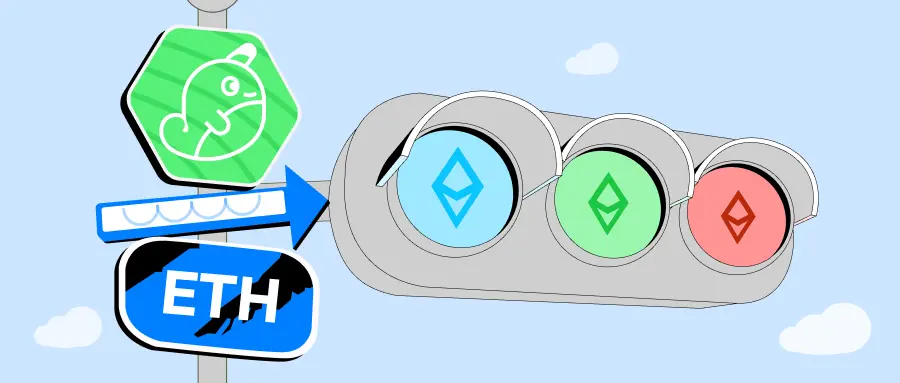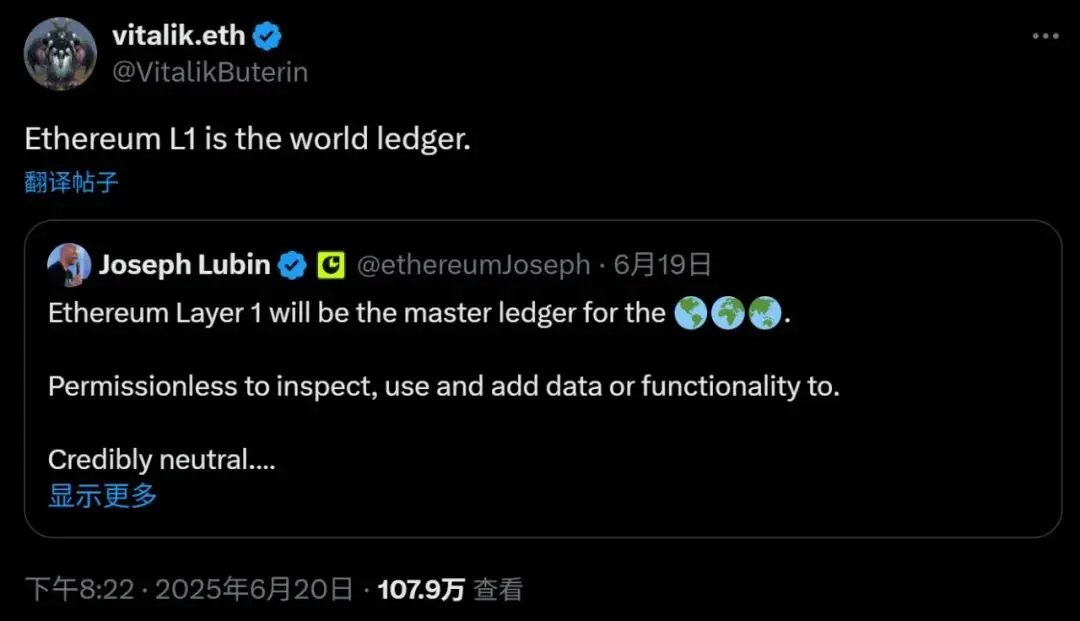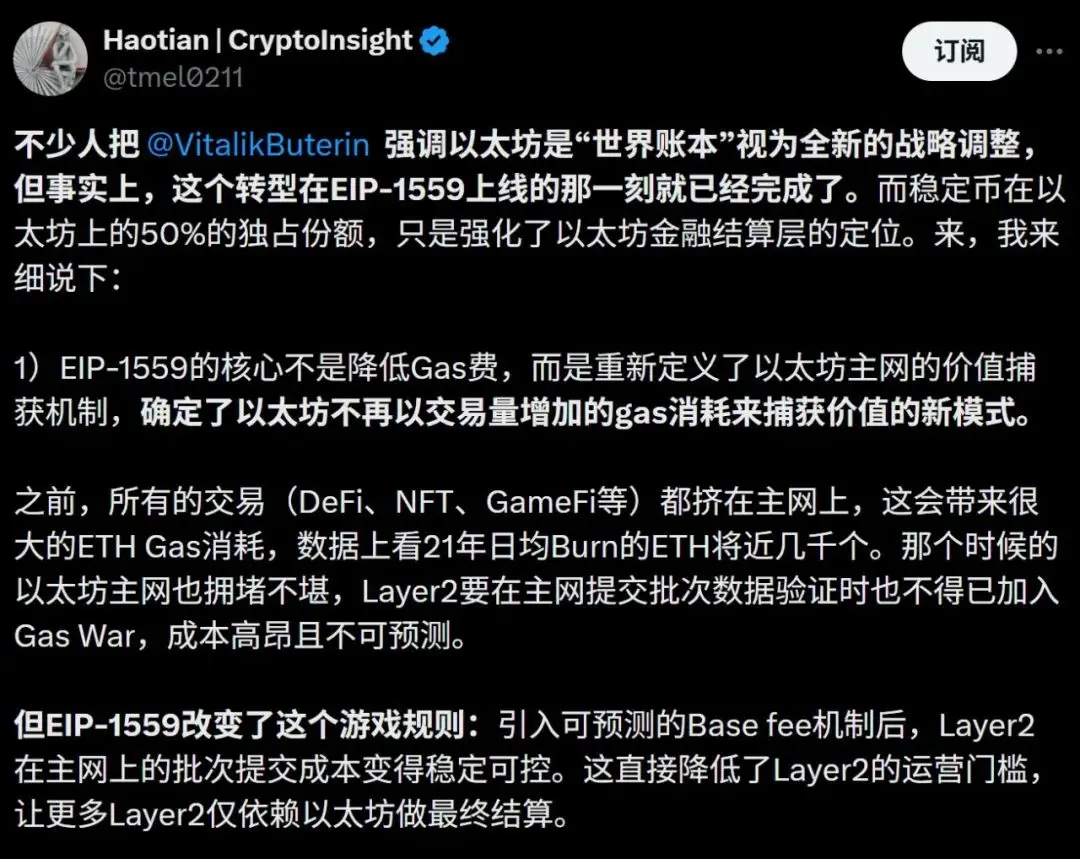How did Ethereum transition from a "World Computer" to a "World Ledger"?

On June 20, Ethereum founder Vitalik Buterin retweeted a post by ConsenSys founder Joseph Lubin, stating that "Ethereum Layer 1 (Ethereum L1) is the world ledger."

This is also a rare statement from Vitalik regarding the recent discussions on Ethereum's macro narrative.
As is well known, in the blockchain world, each public chain generally has a design positioning, which often lays the foundation for its technical architecture and ecological style.
For example, since its inception, Ethereum's ultimate vision has been to build a "World Computer": an open platform that can run any smart contract and support various Web3 application logics. Vitalik has also clearly pointed out that Ethereum is not just a payment network, but a general-purpose decentralized computing layer.
So now, what kind of narrative evolution has occurred in the transition from "World Computer" to "World Ledger"?
01. Ethereum: The Original Intention of the World Computer
In fact, not only Ethereum, but even Bitcoin, which initially proposed the vision of "Electronic Cash," has seen its payment positioning gradually fade as its scale grows and the market evolves, shifting towards a value storage-centric "digital gold."
Objectively speaking, this transformation is a pragmatic choice. After all, BTC, as a representative of crypto assets breaking into the mainstream, has been substantially incorporated into the balance sheets of mainstream financial institutions, gradually becoming one of the core assets in TradFi configurations.
Looking back at Ethereum's development path, we find that while the main narrative has not undergone drastic changes, it has long been in a state of continuous dynamic evolution:
Since 2016, with each market cycle, Ethereum has led as the top smart contract platform, giving rise to numerous on-chain use cases. From ERC20 to DeFi, and then to NFTs and blockchain games, each wave of trends has confirmed the allure of "on-chain computing power."
It can be said that smart contracts have always been at its core, which is why Vitalik has repeatedly emphasized that Ethereum is a decentralized application platform aimed at supporting various Web3 native logics, not just asset transfers. However, at the same time, we have also seen contradictions in reality.
The most criticized issues have naturally been the high Gas fees and low TPS performance problems, which have limited the large-scale implementation of truly complex computational logic. It is against this backdrop that Rollup technology began to gain traction starting in 2020. After five years of development, Ethereum has gradually established a "L1+L2" layered structure.
In this architecture, especially over the past two years, more and more signs indicate that Ethereum is showing signs of becoming a trusted, stable, sovereign-level "World Ledger."
02. Narrative Reconstruction Under L1+L2 Division of Labor
If we were to summarize this division of labor in one sentence, it would be: "The Ethereum mainnet is responsible for security and settlement, while L2 handles high-frequency interactions."
In simple terms, the Ethereum ecosystem has formed a clear division of labor, where the mainnet provides the infrastructure for security and final settlement, while L2 (such as Base, Arbitrum, Optimism, etc.) takes on most high-frequency trading and user operations.
This not only improves scalability but also further strengthens the value capture logic of ETH, naturally positioning the Ethereum mainnet as a "global decentralized ledger." The more successful L2s there are, the more prosperous the ecosystem becomes, and the higher the value of the Ethereum mainnet as a unified ledger.
After all, all L2 networks rely on it as a "central bank" level settlement layer.

As Web3 researcher Haotian stated, EIP-1559 is undoubtedly a key turning point in Ethereum's narrative. It not only introduced the Base Fee and burning mechanism but also fundamentally reshaped Ethereum's value capture method, making Ethereum no longer reliant on the Gas income from a large number of transactions on the mainnet, but instead relying on L2 to achieve continuous "taxation."
In other words, in the past, users were direct customers of the mainnet; now they have become agents operating L2s, responsible for providing services to users, collecting fees, and ultimately "paying" fees to the mainnet in exchange for settlement rights. This mechanism design is reminiscent of the historical "tax farmer system":
- The mainnet becomes the final trusted ledger for transaction clearing and settlement, similar to a central bank;
- L2s act like commercial banks, responsible for high-frequency services to users;
- Each L2 transaction that returns to the mainnet for verification will burn ETH, paying for the ledger's security.
It can be said that Ethereum has not abandoned the vision of a "World Computer"; rather, the L1+L2 division of labor and development path is guiding it to first become a "World Ledger."
03. The Realistic Grounding of the "World Ledger"
Another interesting observation dimension is that each round of ETH's value explosion actually stems from the mainnet being "utilized" in its ledger role.
For instance, the 2017 ERC20 wave served as the clearing and settlement layer for issuing tokens, while the 2020 DeFi Summer was a funding settlement platform under smart contract combinations. Recently, if this wave is reignited by the tokenization of U.S. stocks and RWA (Real World Assets) on-chain, Ethereum remains that trusted ledger.
For TradFi, computational power is certainly important, but what truly determines whether to migrate on-chain is always the ledger's "trust, finality, and security"—this is the core focus for compliant assets.
This is also why platforms like Robinhood are choosing to launch U.S. stock token trading services based on L2s like Arbitrum; the underlying reason is not only recognition of the Rollup architecture's performance but, more importantly, that these transactions will ultimately return to the Ethereum mainnet for settlement.
This indicates that the existing L2 solutions' performance, security, and compliance capabilities are sufficient to meet the trading needs of core traditional financial assets. In a sense, this wave of "U.S. stocks on-chain" has actually reinforced Ethereum's positioning as the global financial clearing and settlement infrastructure, further validating the feasibility and real demand for its "World Ledger" role.
This is the realistic evolution path of Ethereum from a "World Computer" to a "World Ledger"—it no longer merely promises a future of on-chain application scenarios but is increasingly chosen as a settlement endpoint by mainstream assets in the real world.
From this perspective, such trends not only confirm the value of Ethereum L1 but will also profoundly reconstruct the value capture logic of L2, driving the entire Ethereum ecosystem to truly connect between technology and financial infrastructure.
In short, the narratives that can truly drive this chain towards hundreds of millions of users are not just about what Ethereum can do, but rather about:
What the real world is willing to do with Ethereum.
免责声明:本文章仅代表作者个人观点,不代表本平台的立场和观点。本文章仅供信息分享,不构成对任何人的任何投资建议。用户与作者之间的任何争议,与本平台无关。如网页中刊载的文章或图片涉及侵权,请提供相关的权利证明和身份证明发送邮件到support@aicoin.com,本平台相关工作人员将会进行核查。




